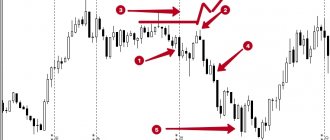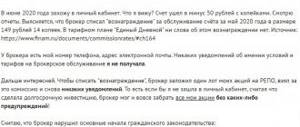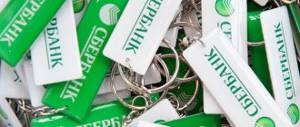For a more in-depth study of the Fundamentals of Wave Analysis, we recommend reading the following books:
- A. Frost and R. Prechter. A complete course on the Elliott Wave Law by B. Williams “Trading Chaos.”
- R. Balan Elliott wave principle - application to the FOREX market.
- D. Vozny. Elliott code. Wave analysis of the Forex market.
- G. Neely. Mastering Elliott Wave Analysis.
- C. Miller. Study of the relationship between the theories of cycles and Elliott waves.
- R. Fisher. New Fibonacci trading methods.
- R. Fisher. Subsequence. Applications and strategies for traders.
- E. Peters. Fractal analysis of financial markets. Application of chaos theory in investment and economics.
- D. Di Napoli. Trading using Di Napoli levels.
- R. Swannell. Market forecast using a new refined pattern recognition system based on the wave principle.
- A. Frost and R. Prechter. The Elliott Wave Principle is the key to understanding the market.
- T. Joseph. Simplified Elliott wave analysis. Practical application of a mechanical trading system.
- D. Murphy. Technical analysis of futures markets.
- A. Cherepkov. Theory of Long Waves by N. D. Kondratiev.
- E. Nayman. Small encyclopedia of a trader.
- A. Kiyanitsa, L. Bratukhin (eds.). Fibonacci levels. Where the money is.
- M. Chekulaev. Fractals.
- V. Safonov. Practical use of Elliott waves in trading.
You can easily find all these books by searching Yandex or Google. We recommend starting with these books:
- A. Frost and R. Prechter have truly provided the most "Complete Course on Elliott Wave Law." This is the main fundamental work on wave analysis of all areas of trading (commodity and commodity markets, stocks, futures, Forex).
- The books by D. Vozny (translator of Prechter into Russian) and Balan are the applied application of wave analysis to the Forex market.
- Bill Wilms's "Trading Chaos" is a more popular publication for a wide range of potential traders. It provides the basics of wave analysis. The author combined them with his Profitunity trading system, consisting of indicators: Alligator, Awesome Oscillator (AO) and Fractals, as well as the bullish/bearish reversal bar pattern.
In order not to get confused in the many smart tips from these books, before reading them we strongly recommend that you study the material in our next chapter : Basics of classical Elliott wave analysis and MasterForex-V know-how. Here you will find a brief summary of the works mentioned.
Part II. Algorithm for technical analysis of trading >>
The expert predicts an increase in Sberbank shares to 350 rubles
MOSCOW, April 27 — PRIME. Positive financial results, expectations of good dividend yield for 2021 and 2021, the recovery of the Russian economy, the reduction of geopolitical risks and the strengthening of the ruble can push up the price of Sberbank’s ordinary shares this year by another 10-18% - to levels of 330-350 rubles, they believe analysts interviewed by RIA Novosti.
Sberbank shares hit historical highs
On Tuesday, ordinary shares of Sberbank rose above 300 rubles for the first time in history – to 300.25 rubles. The bank's preferred shares also reached a historical high and rose to 285.7 rubles. Against this background, the market capitalization of Sberbank exceeded 6.7 trillion rubles.
“Sberbank shares have been showing good dynamics since the middle of last week, which was facilitated by a reduction in geopolitical risks. Also supporting global investor interest in bank stocks, we see the MSCI World Financials index exceeding 2021 highs. Sberbank is fundamentally supported by the economic recovery after the pandemic, as well as the reversal in interest rate dynamics,” says Alfa Bank senior analyst Evgeny Kipnis.
ABOVE 300 RUBLES
Sberbank shares are growing ahead of the reporting, which will be published on April 29, Thursday, also about Yegor Dakhtler.
Securities of Russian companies are traded in London without any dynamics
“Investors are looking for comments and statistics on asset quality. Given the economic recovery, we expect that a large share of borrowers from affected sectors who did not make payments due to the pandemic will gradually return to servicing loans. We also expect to see statistics on non-banking services, based on the results of the ecosystem,” he says.
Sberbank’s reporting under RAS is very good, and, importantly, other Russian banks also have high profitability, which creates optimistic expectations regarding the financial results of the country’s main bank, Andrey Manko from RIA Rating also points out.
In addition, the head of the department of economic and industry analysis of Promsvyazbank, Evgeny Loktyukhov, notes that the triggers for increasing demand for Sberbank shares are the strength of the ruble and the weakening of geopolitical risks, which contribute to the purchase of shares of domestic sectors, as well as the approaching dividend cutoff. He reminds that on May 12, the register of shareholders entitled to receive dividends based on the results of 2021 (18.7 rubles per share) closes.
“The latter factor led to a narrowing of the spread between the bank’s ordinary and preferred shares to less than 5% - for the first time since October,” the expert points out.
WHAT'S NEXT?
Manko from RIA Rating expects a slight decline in quotes after the dividend cutoff, and then a continuation of the upward trend. “We can expect to reach the level of 330 rubles per share this year. Stronger growth will be constrained by risks from loans restructured in 2021,” he believes.
Moscow Exchange lowered the price corridor for MMK shares
Kipnis from Alfa Bank notes that currently the dividend yield on Sberbank securities is 6.2%, and at the end of 2021, in his opinion, it should be higher. Thus, in the absence of negative news on the geopolitical front, the expert does not see any fundamental obstacles to the continued growth of Sberbank shares.
An increase in the value of ordinary shares of Sberbank to 350 rubles per share is quite possible on the horizon of the year, admits Dakhtler "BCS World of Investments".
Loktyukhov from Promsvyazbank has a positive view of Sberbank shares. The target price for the credit institution's ordinary and preferred shares is 355 and 331 rubles, respectively, the analyst believes.
“We note the strength of the bank’s business and its attractive dividend profile - the prospect of significant growth in net profit this year allows us to count on good dividend payments on its shares at the end of 2021. We believe that these factors will allow the bank’s shares to quickly recover from the natural post-dividend decline and consider it justified to pass the dividend “cut-off” “in the papers,” the expert recommends.
Read more:
Part III. Wave analysis of trading: Elliott classics, problems and their solutions in the Masterforex-V trading system
- Chapter 2. Basics of classical Elliott wave analysis and MasterForex-V know-how
- Chapter 3. Basics of classical Elliott wave analysis
Book 1. Secrets of mastery from a professional trader (or what Bill Williams, Alexander Elder, Eric Nyman and others did not tell traders about Forex) >>
Book 3. Points of opening and closing transactions on the Forex market / Forex (basic rate) >>
Get professional training in Forex and stock trading >>
Is it profitable to invest in Sberbank: forecast for 2021
According to the results of the latest quarterly report (for the 3rd quarter), the bank's net profit amounted to slightly more than 156 billion rubles. There was a decrease, but the result was higher than expected. A decrease to 146 billion rubles was expected. The reason is the sale of the Turkish subsidiary of Denizbank.
Over the 11 months of this year, profit increased by >7% to RUB 814 billion. Dirty profit before taxes exceeded 1 trillion. rub.
Creating its own banking ecosystem will allow Sberbank to reach new levels of income. Strategy 2021 provides for systematic work in this direction.
The latest news is the creation of a joint venture with Mail Group for food delivery and taxi ordering services.
Taking into account Sberbank's policy of increasing dividends, the bank's shares are interesting for long-term investment. The price of Sberbank securities is above 300 rubles. doesn't seem like a fantastic option.
What to do in such cases?
If the increase in the amount in the repayment window suddenly took on a more global scale or changed significantly in one direction or another, this may already be a cause for concern. The best solution to the problem is to contact customer support. It is here that specialists can provide information about the current status of accounts, the size of debt obligations and some other significant points. When contacting employees in person or through a hotline, it is worth preparing your passport and remembering the code word (it will be needed when making a call).
Providing a timely signal of any such changes is a good practice for any borrower. After all, a failure that was not noticed on time or a late payment that was not credited in a timely manner is quite capable of significantly complicating the relationship with the bank.
Rate the author
(
1 ratings, average: 5.00 out of 5)
Share on social networks
Author:
Mortgage specialist Maria Yurievna Sokhan
Date of publication March 6, 2019 September 22, 2020
When can this happen?
How to find out why the mortgage amount in Sberbank online is growing monthly or daily? In fact, when using a differentiated payment system, when the main part of the interest is repaid first and only then the body of the loan is repaid, changes can be observed daily. This also happens with annuity (equal) payments. This is due to the peculiarities of the processes within which interest is automatically calculated . The higher the amount of mortgage debt, the greater the amount will arrive.
If the statement is ordered once a month, there should be no deviations from the pre-calculated indicators - the amounts will completely coincide with the calculated values. So, before you sound the alarm, you should wait until the end of the billing period. Then the discrepancies in the numbers will easily fall into place.
When do changes occur that frighten borrowers? Within a month, depending on the repayment date - from the day following payment until payment is made. Information on such statistics is needed by those who want to separately contribute part of the funds for the early closure of the main body of the debt or want to contribute the entire amount at a time.
Recommended article: How to calculate a VTB mortgage online - step-by-step instructions
What will change for the bank and its clients
Russian Finance Minister Anton Siluanov assured journalists today that “the change of the controlling shareholder will not in any way affect the state’s guarantees for citizens’ deposits,” and, according to him, the current strategy of the state bank will remain unchanged. Previously, the head of the credit institution stated that he would leave the post of head of Sberbank if the main vector of development of the credit institution was changed after the change of the main shareholder.
Market participants also note that the impact on the bank’s clients and on the vector of its development will be neutral. “The state will still remain the controlling shareholder of Sberbank and it is unlikely that significant changes in strategy can be expected. From the point of view of clients and depositors, this change can be considered neutral,” Anton Lopatin, director of the analytical group for financial organizations of the international rating agency Fitch, told TASS.
A similar opinion was expressed by Alexander Proklov, senior managing director of the NKR rating agency. According to him, if any changes in the strategy of the country's largest bank occur, their preparation and discussion will take quite a long time.
“For ordinary citizens, there will be no changes in the bank’s activities related to the sale of shares to the government of the country,” he said.
Why is a change of shareholder necessary?
The Ministry of Finance noted that the sale by the Bank of Russia of shares in Sberbank will eliminate questions regarding conflicts of interest and equidistance between the regulator and financial market participants. According to Konstantin Korishchenko, head of the department of stock markets and financial engineering at the Faculty of Finance and Banking of the Russian Presidential Academy of National Economy and Public Administration, the logic of such a change of shareholder for a state bank is quite transparent.
“The Central Bank is the supervisory body over the banking system, in this sense there is a fairly understandable conflict of interest that the Central Bank has in its role as a supervisory body and a shareholder. Risks that could be associated with the exit of the Russian state, relatively speaking, and the capital of Sberbank in the event of an acquisition by the Ministry of Finance, are removed, since Sberbank was a state bank and, in fact, will remain so,” he notes.
Deputy Aksakov recalled that when a similar transaction took place with VTB shares, no difficulties arose.
“We made a decision on VTB Bank at the beginning of the 2000s, VTB did not experience any problems due to the change of owner. I think that even now there won’t be any particular problems for Sberbank,” he said.
What will happen to the National Welfare Fund
The Ministry of Finance emphasized that the National Welfare Fund's investments in Sberbank shares correspond to the goals of fund management - ensuring the safety of invested funds and stable income from their placement. Experts interviewed by TASS also note that the deal will not interfere with infrastructure projects, and the National Welfare Fund has enough funds to implement such a deal.
“In my opinion, the deal does not interfere with infrastructure projects: the purchase of foreign currency from additional oil and gas revenues will continue, and in the middle of the year, when the currency purchased in 2019 will be transferred to the National Welfare Fund, the procedure for spending in excess of standard volumes will be announced. What is really changing is the net volume of participation of the Ministry of Finance and the Central Bank of the Russian Federation in the foreign exchange market: the net acquisition of foreign currency will decrease, which means, other things being equal, a stronger ruble. Slowing down the devaluation of the ruble will support social stability and become an additional counter-inflationary factor,” says Valery Weisberg, director of the analytical department of the Region Investment Company.
Chief economist of Alfa Bank Natalya Orlova noted in an interview with TASS that the National Welfare Fund is the only source of funds for this type of transaction. “This deal is being carried out now, when the funds of the National Welfare Fund have reached 7% of GDP, that is, roughly speaking, the National Welfare Fund has enough funds to implement such a deal. In any case, the government has no other sources to finance such a deal,” she said.
Konstantin Korishchenko from RANEPA called the spending of the National Welfare Fund on the purchase of Sberbank shares from the Central Bank “shifting from one pocket to another.”
“If we talk about how expedient it is to use the National Welfare Fund, then this is an absolutely technical question. The Central Bank received Sberbank shares a long time ago, and their value at the time of acquisition was much lower than today. Consequently, almost all the funds that the Central Bank receives will go to profit. And the profits of the Central Bank, as we know, are transferred to the government. Therefore, in fact, from an accounting point of view, there will be a transfer of part of the funds from the National Welfare Fund to the current budget. That is, the 2021 profit transferred by the Central Bank to the Ministry of Finance will be higher in the 2020 budget by the amount of money coming out of their National Welfare Fund. In essence, this is transferring from one pocket to another,” Korishchenko noted.











